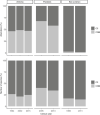CAM plants: their importance in epiphyte communities and prospects with global change
- PMID: 36617243
- PMCID: PMC10799991
- DOI: 10.1093/aob/mcac158
CAM plants: their importance in epiphyte communities and prospects with global change
Abstract
Background and scope: The epiphytic life form characterizes almost 10 % of all vascular plants. Defined by structural dependence throughout their life and their non-parasitic relationship with the host, the term epiphyte describes a heterogeneous and taxonomically diverse group of plants. This article reviews the importance of crassulacean acid metabolism (CAM) among epiphytes in current climatic conditions and explores the prospects under global change.
Results and conclusions: We question the view of a disproportionate importance of CAM among epiphytes and its role as a 'key innovation' for epiphytism but do identify ecological conditions in which epiphytic existence seems to be contingent on the presence of this photosynthetic pathway. Possibly divergent responses of CAM and C3 epiphytes to future changes in climate and land use are discussed with the help of experimental evidence, current distributional patterns and the results of several long-term descriptive community studies. The results and their interpretation aim to stimulate a fruitful discussion on the role of CAM in epiphytes in current climatic conditions and in altered climatic conditions in the future.
Keywords: Carbon isotopes; crassulacean acid metabolism; disturbance; dry forest; epiphytes; functional traits; germination; global change; key innovation; plant–water relationships.
© The Author(s) 2023. Published by Oxford University Press on behalf of the Annals of Botany Company. All rights reserved. For permissions, please e-mail: journals.permissions@oup.com.
Figures


References
-
- Benzing DH. 1989. The evolution of epiphytism. In: Lüttge U, ed. Vascular plants as epiphytes: evolution and ecophysiology. Heidelberg: Springer, 15–41.
-
- Benzing DH. 1990. Vascular epiphytes. General biology and related biota. Cambridge: Cambridge University Press.
-
- Benzing DH, Bent A, Moscow D, Peterson G, Renfrow A.. 1982. Functional correlates of deciduousness in Catasetum integerrimum (Orchidaceae). Selbyana 7: 1–9.
-
- Benzing DH, Burt KM.. 1970. Foliar permeability among twenty species of the Bromeliaceae. Bulletin of the Torrey Botanical Club 97: 269–279. doi: 10.2307/2483646. - DOI
Publication types
MeSH terms
LinkOut - more resources
Full Text Sources
Miscellaneous

